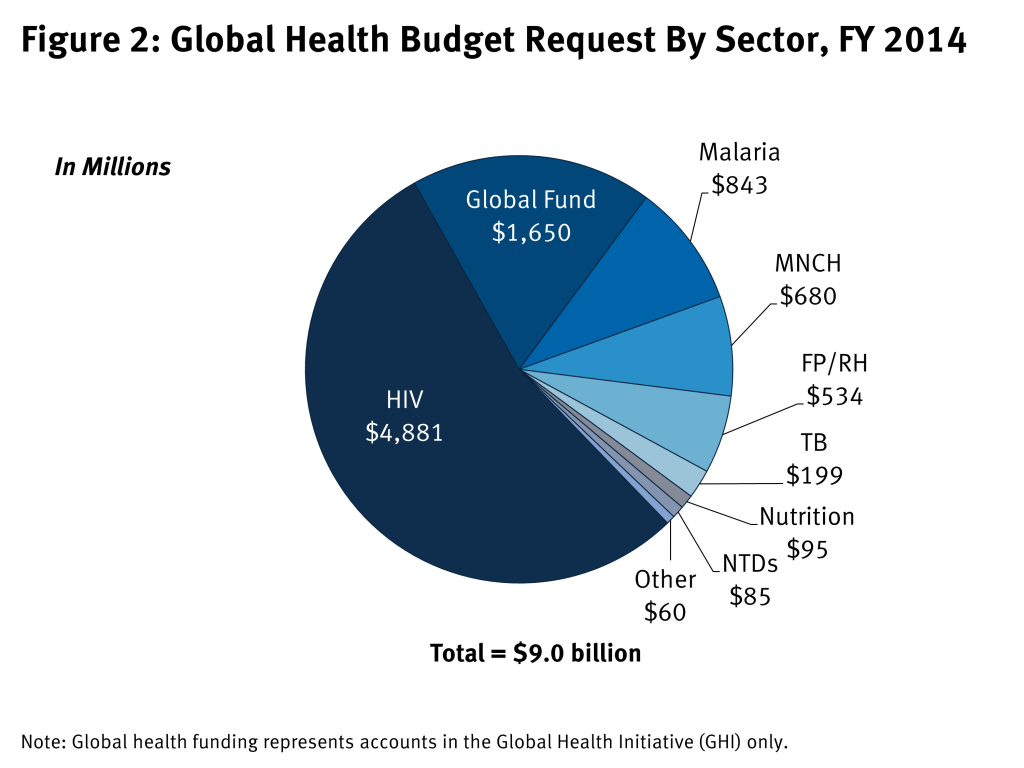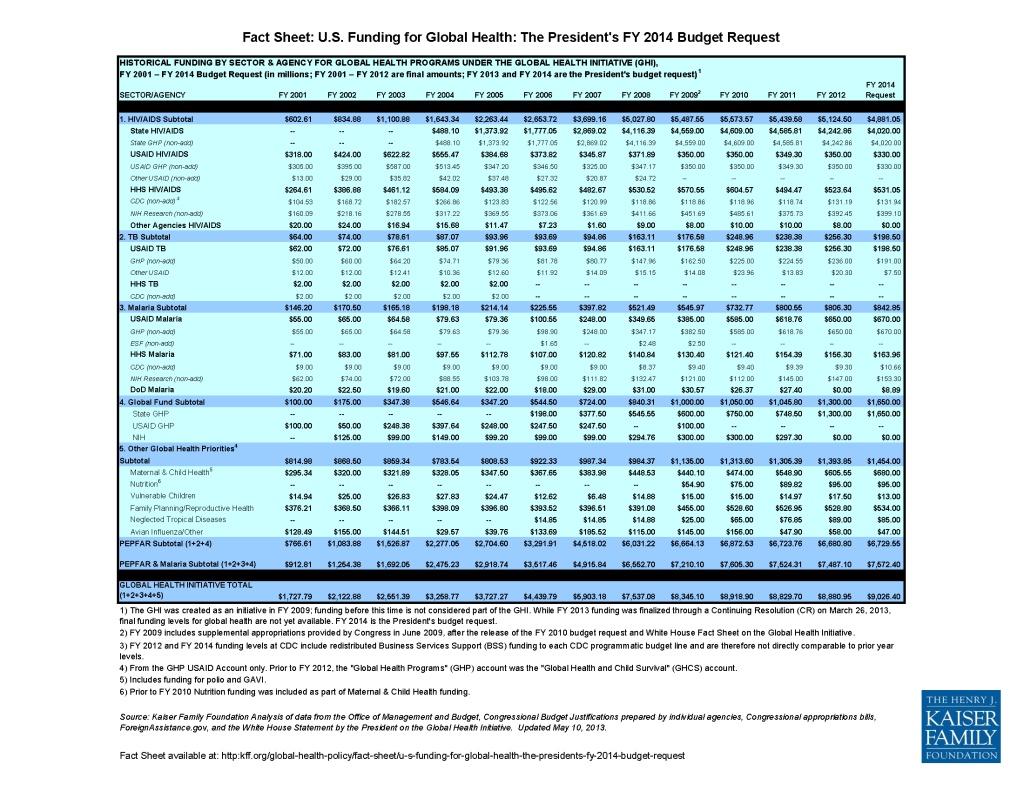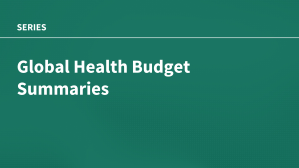U.S. Funding for Global Health: The President’s FY 2014 Budget Request
President Obama’s Fiscal Year (FY) 2014 federal budget request, released on April 10, includes an estimated $9.0 billion for global health programs under the Global Health Initiative (GHI).1 This would represent a 1.6% increase ($145 million) above FY 2012, which totaled $8.9 billion.2 Because funding for the current fiscal year, 2013, was only recently completed through a Continuing Resolution (CR) (signed by the President on March 26, 2013), which continued funding at FY 2012 levels for many programs, although made changes to others, and includes rescissions and a mandated sequestration, funding levels are not yet available for most global health programs; therefore comparisons made here are between the FY 2014 budget request and FY 2012, unless otherwise noted.3 Detailed data for FY 2009-FY 2014 are provided in Table 1.
Understanding the Global Health Budget

The U.S. government provides funding for global health programs through several agencies and multiple accounts. The agencies include the Department of State, U.S. Agency for International Development (USAID), National Institutes of Health (NIH), Centers for Disease Control and Prevention (CDC), and the Department of Defense (DoD).4 The main accounts are Global Health Programs (GHP), Development Assistance (DA), Economic Support Fund (ESF), and International Organizations and Programs (IO&P), all of which are managed by the State Department and USAID.5
In 2009, President Obama launched the Global Health Initiative (GHI), which acts as an “umbrella” over most but not all existing U.S. global health programs, accounting for more than 80% of the U.S. global health funding investment.6 The GHI brings together several different existing funding streams for global health, most of which are designated by Congress for specific global health activities but which have not historically been aggregated into a single “global health budget.”7 These include funding for: HIV/AIDS, tuberculosis (TB), and the Global Fund to Fight AIDS, Tuberculosis and Malaria (Global Fund) under the President’s Emergency Plan for AIDS Relief (PEPFAR); malaria, including the President’s Malaria Initiative (PMI); neglected tropical diseases (NTDs); maternal, newborn and child health (MNCH); family planning and reproductive health (FP/RH); and nutrition.
The GHI funding umbrella does not include all U.S. funding for global health. For instance, some funding for MNCH, nutrition, and FP/RH; funding for water, sanitation, and hygiene (WASH) programs; funding for health projects under the Millennium Challenge Corporation (MCC); and most global health activities carried out by the Department of Defense (DoD) are not included in its total. Since these funding amounts are usually determined at the agency level, and may not be earmarked by Congress, they are not included in this analysis.
Funding for global health is entirely discretionary, determined annually by Congress during the appropriations process. Since there are five U.S. government (USG) departments and agencies that receive appropriations for global health programs – United States Agency for International Development (USAID), Department of State, National Institutes of Health (NIH), Centers for Disease Control and Prevention (CDC), and Department of Defense (DoD) – funding is subject to multiple appropriations bills and Congressional appropriations subcommittees.
Status of the FY 2013 Global Health Budget8
While Congress finalized FY 2013 appropriations prior to release of the FY 2014 budget request, funding amounts for most programs are not yet known, in part due to the impacts of sequestration. Additionally, the only global health funding levels specified by Congress for FY 2013 were HIV bilateral funding ($4,070 million) through the Department of State, funding for the Global Fund ($1,650 million), and a topline global health funding level at USAID ($2,756 million), without specific funding levels by programmatic area. Due to uncertainty in FY 2013 final funding levels, all FY 2014 comparisons are to FY 2012 levels.
FY 2014 Global Health Budget Snapshot8
- The FY 2014 budget request for global health of $9.0 billion represents an increase of $145 million, or 1.6%, above FY 2012 levels.
- The majority of global health funding in the FY 2014 budget request is directed to the State Department ($5.7 billion), followed by USAID ($2.7 billion). The Department of Health and Human Services, through NIH and the CDC, receives the third highest share ($0.7 billion) in the FY 2014 request, and a small amount goes to the Department of Defense.
- The majority of global health funding is provided through bilateral programs, which account for 78% ($7.1 billion) of the FY 2014 budget request.
- $2.0 billion of the global health FY 2014 budget request, or 22%, is for contributions to multilateral organizations including the Global Fund, the Global Alliance for Vaccines and Immunisation (GAVI), the International AIDS Vaccine Initiative (IAVI), and the Joint United Nations Programme on HIV/AIDS (UNAIDS). U.S. contributions to the Global Fund ($1.65 billion) account for the largest share of multilateral funding in the request.
- Funding for PEPFAR, which includes HIV/AIDS, TB, and the Global Fund, totals $6.7 billion, or 75%, of the global health budget request. This represents an increase of $49 million, or 0.7%, above FY 2012 PEPFAR totals, but is $142 million below the highest level of funding in FY 2010.
FY 2014 Global Health Budget by Program Area[footnote KFFAnalysis FY14CBJ FtFGuide]
GHI activities are focused on 9 program areas. In some, but not all areas, funding is provided by multiple agencies and/or accounts. In the FY 2014 budget request, funding for these areas is as follows:

- HIV/AIDS: Funding for bilateral HIV/AIDS totals $4.9 billion in the FY 2014 budget request, a decrease of $243 million (5%) below FY 2012. HIV/AIDS funding, part of PEPFAR, comprises the largest portion (54%) of the global health budget. The majority of funding for HIV/AIDS is provided to the State Department ($4.0 billion) followed by NIH ($399 million), USAID ($330 million), and the CDC ($132 million).
- TB: Funding for bilateral TB totals $199 million, a decrease of $58 million (23%) below FY 2012, the largest percentage decrease among all global health program areas and the lowest level of TB funding since FY 2009. All TB funding is considered part of PEPFAR and is primarily overseen by USAID.
- Malaria: Malaria bilateral funding is $843 million in the FY 2014 budget request, an increase of $37 million (5%). The majority of this funding is directed to the President’s Malaria Initiative (PMI), first launched in 2005 and led by USAID. NIH ($153 million) and the CDC ($11 million) also receive funding dedicated to malaria activities.
- Global Fund: The U.S. contribution to the Global Fund is $1.65 billion in the FY 2014 budget request, an increase of $350 million, or 27%, above FY 2012. Funding is provided entirely through the State Department and is used by the Global Fund to support HIV, TB, and malaria programs in low- and middle-income countries.
- NTDs: Funding aimed at addressing NTDs is $85 million in the request, a decrease of $4 million (4%) below FY 2012.
- MNCH: Global health funding for MNCH under the GHI is $680 million in the request, an increase of $74 million (12%) above FY 2012. This includes $175 million for GAVI. Additional U.S. funding for MNCH efforts provided through other accounts administered by USAID and the State Department (e.g. the U.S. contribution to the United Nations Children’s Fund) is not currently counted as part of the GHI.
- FP/RH: Global health funding for FP/RH under the GHI is $534 million in the request, an increase of $5 million (1%) over FY 2012. More than $100 million in additional U.S. funding for FP/RH efforts provided through other accounts administered by USAID and the State Department, including the $37 million U.S. contribution to the United Nations Population Fund, is not currently counted as part of the GHI.
- Nutrition: Funding for nutrition totals $95 million in the FY 2014 request matching the FY 2012 funding level. Nutrition programs under the GHI are coordinated with the U.S. Feed the Future (FTF) Initiative.

Figure 3: Global Health Funding, Percent Change by Sector, FY 2012-FY 2014
Looking Forward
U.S. global health programs, like many U.S. programs, face the challenge of being implemented during a time of significant budgetary uncertainty, spending scale-backs, and potential trade-offs in funding between program areas. While funding for U.S. global health programs has fared relatively well in the current budget environment, it too has been subject to funding pressures and reductions in some areas. With funding levels for FY 2013 not yet finalized for all global health programs, including the unknown impacts of sequestration, combined with continued efforts to address budgetary constraints, uncertainty over final global health funding levels remains.

Kaiser’s Budget Tracker will monitor the plan as Congress considers and revises it during the budget and appropriations process.
- KFF analysis of data from: FY 2014 Budget of the United States and Congressional Budget Justifications; Congressional Appropriations Bills and Conference Reports; Agency operational plans; ForeignAssistance.gov; Office of Management and Budget, personal communication, April 2013. ↩︎
- KFF analysis of data from: FY 2014 Budget of the United States and Congressional Budget Justifications; Congressional Appropriations Bills and Conference Reports; Agency operational plans; ForeignAssistance.gov; Office of Management and Budget, personal communication, April 2013. ↩︎
- U.S. Congress. Public Law No: 113-6, March 26, 2013. ↩︎
- KFF. “The U.S. Government Engagement in Global Health: A Primer,” January 2013. ↩︎
- KFF. “The U.S. Government Engagement in Global Health: A Primer,” January 2013. ↩︎
- The White House, Office of the Press Secretary. Statement by the President on Global Health Initiative; May 5, 2009. ↩︎
- KFF. “The U.S. Global Health Initiative: Overview and Budget Analysis,” December 2009: http://modern.kff.org/globalhealth/8009.cfm. ↩︎
- U.S. Congress. Public Law No: 113-6, March 26, 2013. ↩︎
